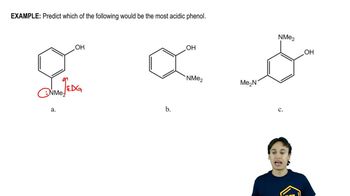Here are the essential concepts you must grasp in order to answer the question correctly.
Electrophilic Aromatic Substitution
Electrophilic aromatic substitution (EAS) is a reaction in which an electrophile replaces a hydrogen atom on an aromatic ring. In the context of phenol, the hydroxyl group activates the benzene ring towards electrophilic attack, making it more reactive. The presence of HOCl can lead to chlorination of the aromatic ring, typically at the ortho or para position relative to the hydroxyl group.
Recommended video:
Oxidative Cleavage with Periodic Acid (HIO₄)
HIO₄ is a reagent used for oxidative cleavage of vicinal diols, breaking the C-C bond between them to form carbonyl compounds. However, in the case of phenol, there are no vicinal diols present, so HIO₄ would not react with the structure. Therefore, no reaction is expected when phenol is treated with HIO₄.
Recommended video:
Monosaccharides - Oxidative Cleavage
Phenol Reactivity
Phenol is an aromatic compound with a hydroxyl group directly attached to the benzene ring, which significantly influences its reactivity. The hydroxyl group donates electron density into the ring, enhancing its reactivity towards electrophiles. This makes phenol more susceptible to reactions like halogenation, where electrophiles such as HOCl can add to the ring, typically at the ortho and para positions.
Recommended video:
Identify the most acidic phenol

 Verified step by step guidance
Verified step by step guidance Verified video answer for a similar problem:
Verified video answer for a similar problem:

